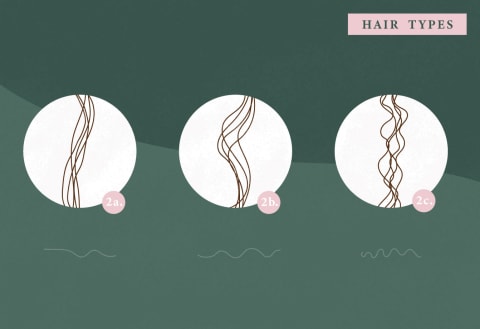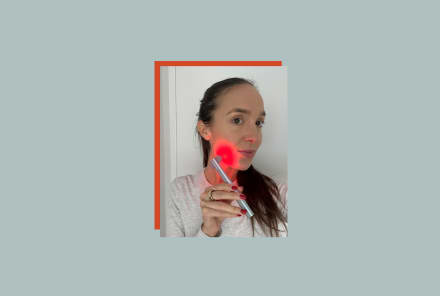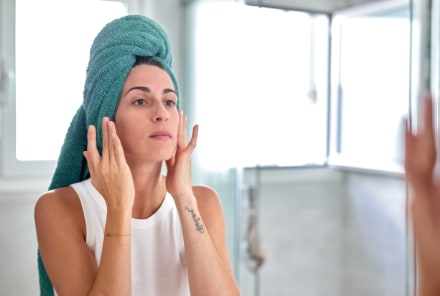Advertisement
Type 2 Hair: Our Full Guide To Styling & Caring For Curly Hair

You likely know how to classify your hair type under broad strokes—is it stick straight, loose waves, springy curls, or lush kinks and coils? Certainly a good place to start. But as any hair care fanatic would know, there are several other, smaller classifications that can help you better care for and style your hair. Enter hair types, which range from 1 (straight) to 4c (tight kinks). These subtypes can help us further describe hair using a common language so we can better understand what's happening on our heads. Here, we're looking at Type 2, or the wavy end of the spectrum.
Hair type
A short debrief on hair types, in the event you need a refresher. Like we noted, hair is categorized into types from 1 to 4, each with three smaller subsets noted as A, B, or C. Hair types aren't scientific terms (so this isn't a set standard crafted up by derms or researchers), but it's pretty universally accepted among hairstylists, trichologists, and even many derms themselves! (It was actually made famous by Oprah's hairstylist Andre Walker, so we have another thing to thank Oprah for.)
As a rundown: Type 1 is straight, with the variance usually coming to how flat your hair lies. Type 2 is wavy, with the major differences depending on how loose the S-pattern is. Type 3 is curly, which changes depending on how tight the curl is. And Type 4 is kinky or coily, which changes depending on whether the shape of the pattern is more zigzag or springs.
Finding your hair type.
Listen, you may find yourself here because you already know your hair type pretty well. But for those of you who need a bit more guidance, we actually created an mbg hair type quiz that takes only a few minutes. So click the link below and come back here when you have your results.
But this isn't an exact science: Most people have a few patterns to deal with or a patch or two that doesn't seem to fit in with the rest. So you might have to do different techniques for different areas to make it all uniform. (Or embrace the unique textures!) And there are other factors at play: hair porosity, density, and strand thickness. Essentially you've just got to get to know yourself.
"I cannot stress studying your hair enough. A stylist can only give you recommendations, but essentially you go home with your hair," says Danielle Malary, owner of Lumiere Vive Salon. "Feel your hair out, document how it reacts. Essentially, keep a journal for your hair and learn to love it."

Type 2a hair
This is the loosest of the patterns and is usually only a handful of slight bends in the hair. These tend to lie pretty flat on the head and can be easily straightened with hot tools, like flat irons or blow dryers.
Styling tips:
- As this type gets flat at the roots, adding volume is likely a priority for many. You can check out our guide to adding lift to flat roots here.
- This hair type can also get oily faster, so they may need to wash their hair more often than curlier types. While everyone's wash schedule is different—it's influenced by your hair length, type, lifestyle needs, and scalp—you'll likely find you fare better with more frequent shampoos.
- You may even consider a scalp scrub: "Clarifying the hair every so often is a great step," explains texture specialist and artistic director at Matrix Michelle O'Connor.
- If you want to amp up your texture, there are plenty of heatless ways to give your strands some curl.
Type 2b hair
You'll see a touch more bend to the S-shape, particularly from the midshaft to the end. The root still lies pretty flat against the scalp.
Styling tips:
- While we are not ones to suggest using dry shampoos with regularity—they can clog the pores on your scalp and cause buildup!—those with flat, oil-prone roots can absolutely use them as styling products when the occasion calls for it. This is especially true for this hair type, as it tends to be a bit drier than 2a (the curlier, the more prone to brittleness) and therefore you may not shampoo as much. A clean, scalp-supporting dry shampoo can keep your roots lifted between washes.
- You'll want to encourage the waves post-wash to help them get a bit of definition. Find a light-hold curl cream that you enjoy, and scrunch it throughout your hair when damp. From there, air-dry the strands—and try not to touch them too much as that can disrupt the pattern and cause frizz.
- You'll want to be mindful of how much product you're applying: Less is more here! This hair type can get weighed down pretty quickly, so don't overdo it.
- Towel dry before applying product, as this can add volume to the hair. According to hairstylist and founder of Hair Rules Anthony Dickey, "If you have a flatter texture, you'll want to remove more water from the hair before you start your styling technique."
Type 2c hair
Here, there will be a very defined S to the strands. This is the closest to curly hair, and most often people with 2c hair have a few sections with proper ribbons of curls. There's more lift at the root, and it's also (usually) more frizzy.
Styling tips:
- Hair plopping is a technique using none other than a T-shirt to gently absorb any excess water. Essentially, it's all in the name—you simply plop your hair on the top of your head for it to dry inside the tee. It also simultaneously scrunches your strands, so you can achieve voluminous, defined curls, sans frizz. Check out our full guide here.
- Since this is on the curly end of the wavy spectrum, you can play around with styling creams to really amp up the shape. The LOC method is great for playing around with textures, ingredients, and product types to get your ideal cocktail.
- Since this type is prone to more frizz than the others, you may look for smoothing products (like shampoos and conditioners) to help tame the hair.
Other hair traits to consider.
Hair type is not the only thing to consider when styling and caring for your hair. Many variables play a factor in overall appearance and should be kept in mind as you look for products, styling tools, and advice.
Hair porosity
"Hair porosity describes how the hair's cuticle absorbs and holds on to moisture in its pores—hence, the term porosity," says hairstylist Miko Branch, co-founder of hair care brand Miss Jessie's. Hair porosity is a spectrum, ranging from high to low. High porosity means the cuticles are more open, so hair absorbs water easily. But it also means it evaporates easily. Hair that has low porosity has dense cuticles. This means the hair has a harder time absorbing water, product, or even your scalp's natural oils, and you'll see buildup faster. It also takes longer to dry after getting wet as it's holding all that water in. Then you can fall somewhere between these two ends of the spectrum, which is considered medium porosity. You can take our hair porosity quiz for more information.
Hair density
Hair density is basically how full your head of hair is. According to celebrity hairstylist Ryan Richman, "The density of the hair is determined by how close your hair strands are to each other. This, in turn, determines how thin or thick your hair appears." Scalps with more hair follicles can often appear lush—but may also be drier (especially at the ends) and harder to manage. Scalps with low density may mean wider parts and thinner styles but can usually pull off blunt cuts, says Richman.
Hair thickness
This refers to the diameter of the strand. Thin strands have a small circumference, while thick strands are larger.
The takeaway.
For wavy—or type 2 hair—you have plenty of options to play up those waves. Just be mindful of other factors (i.e., those mentioned in the last section), and you'll soon see waves of your dreams.
Here are our favorite products for curly hair.
Watch Next
Enjoy some of our favorite clips from classes
Enjoy some of our favorite clips from classes
What Is Meditation?
Mindfulness/Spirituality | Light Watkins
Box Breathing
Mindfulness/Spirituality | Gwen Dittmar
What Breathwork Can Address
Mindfulness/Spirituality | Gwen Dittmar
The 8 Limbs of Yoga - What is Asana?
Yoga | Caley Alyssa
Two Standing Postures to Open Up Tight Hips
Yoga | Caley Alyssa
How Plants Can Optimize Athletic Performance
Nutrition | Rich Roll
What to Eat Before a Workout
Nutrition | Rich Roll
How Ayurveda Helps Us Navigate Modern Life
Nutrition | Sahara Rose
Messages About Love & Relationships
Love & Relationships | Esther Perel
Love Languages
Love & Relationships | Esther Perel

















